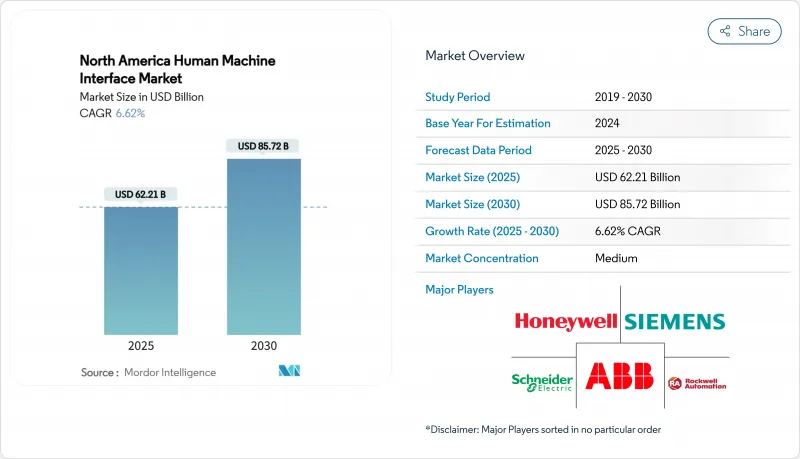
|
市場調査レポート
商品コード
1851316
北米:ヒューマンマシンインタフェース市場シェア分析、産業動向、統計、成長予測(2025年~2030年)North America Human Machine Interface - Market Share Analysis, Industry Trends & Statistics, Growth Forecasts (2025 - 2030) |
||||||
カスタマイズ可能
適宜更新あり
|
|||||||
| 北米:ヒューマンマシンインタフェース市場シェア分析、産業動向、統計、成長予測(2025年~2030年) |
|
出版日: 2025年07月10日
発行: Mordor Intelligence
ページ情報: 英文 120 Pages
納期: 2~3営業日
|
概要
北米:ヒューマンマシンインタフェース市場は、2025年に622億1,000万米ドルに達し、2030年には857億2,000万米ドルに達し、CAGR 6.62%で成長すると予測されています。

この地域のインダストリー4.0への推進、プライベート5Gの展開、OSHA-NISTサイバーフィジカルルールの厳格化によって需要は拡大し、メーカーはレガシーオペレータパネルを安全なデータ中心のシステムに置き換えることを余儀なくされます。現代の工場では、HMIが単に機械の状態を伝えるだけでなく、リアルタイムの生産データをクラウド分析にストリーミングすることを期待するようになっており、この期待はディスクリートおよびプロセス産業全体の調達戦略を変えつつあります。半導体の供給不足とOT-IT統合の人材不足が当面の足かせとなる一方で、EVバッテリーのギガファクトリーをはじめとする新たな生産能力増強が、複数年にわたるプロジェクト・パイプラインを支え続けています。その結果、ハードウェア、ソフトウェア、サイバーセキュリティ機能を融合したベンダーが、北米:ヒューマンマシンインタフェース市場で優位な競争力を占めています。
北米:ヒューマンマシンインタフェース市場の動向と洞察
米国のディスクリート製造業におけるインダストリー4.0導入の増加がコネクテッド・マシン・インターフェイスの需要を促進
自動車、エレクトロニクス、パッケージ製品ラインの工場管理者は現在、PLCロジック、MESトランザクション、品質分析を1つのHMI傘下に統合するシングルデータファブリック戦略を追求しています。2025年エルメス賞を受賞したシーメンスのIndustrial Copilotは、コードの堅牢性を高めながらエンジニアリング時間を削減するジェネレーティブAIを組み込んでいます。フォードは、ルイビルの組立工場全体にソフトウェア定義のSIMATIC Automation Workstationを統合し、生産セルを数日ではなく数時間で再構成できるようにしました。中堅の受託製造企業における同様の導入は、固定機能パネルから、予知保全とエネルギー最適化をサポートするスケーラブルでソフトウェア中心のHMIへの構造的なシフトを示しています。これらのアップグレードは、北米:ヒューマンマシンインタフェース市場の対応可能ベースを直接拡大します。
OSHAとNISTのサイバーフィジカル・コンプライアンス指令がHMIのアップグレードを後押し
規制当局は現在、保護されていないHMIを安全リスクとして扱っています。OSHAは、NIST SP 800-82を参照し、製薬会社や化学会社にリモートアクセスポイントの強化や多要素認証の実装を促しています。2024年のCISA勧告では、広く配備されているオペレータ・ステーションにSQLインジェクションの欠陥があることが指摘され、企業はサポートされていないバージョンをリタイアするよう促されました。コンプライアンス違反のコストは近代化予算を凌駕し、資本は暗号化されたプロトコルと役割ベースのアクセスに振り向けられます。IEC 62443規格にパネルを事前認証するベンダーは、北米:ヒューマンマシンインタフェース市場全体で市場以上の成長を報告しています。
レガシーHMI通信プロトコルに根強い脆弱性
CISAの2025年カタログでは、パッチ未適用の端末でリモート・コードの実行を可能にするmodbus-TCPとDNP3の脆弱性が強調されており、プラントのOTリスクに対する取締役会レベルの監視が強化されています。北米の施設の多くはいまだにエアギャップイリュージョンに依存しているため、新たに公開された脆弱性が老朽化したパネルの交換計画を加速させています。しかし、ブラウンフィールド配線の複雑さとライン停止を演出する必要性が相まって、完全な移行は遅れています。
セグメント分析
2024年のプログラマブルロジックコントローラの市場規模は174億2,000万米ドルで、総支出の28%を占める。MESプラットフォームは、規模は小さいもの、クローズドループ品質とリアルタイム原価計算への軸足を反映して、2030年まで毎年9.5%成長します。ベンダーはモーション、セーフティ、エッジアナリティクスを新世代のPLCに統合し、キャビネットの設置面積を縮小すると同時に、エンタープライズクラウドへのデータスループットを拡大します。エレクトロニクス分野の早期導入企業は、PLCタグをMESダッシュボードに統合した後、12%以上のスクラップ削減を目の当たりにしています。プロセス産業ではSCADAとDCSソリューションが牙城を保つ一方、CFOは設備投資をオペックスに変換するサブスクリプションモデルを優先するため、クラウドホストのHMIソフトウェアが永久ライセンスを上回っています。このような技術の収束により、技術は共食いすることなく相互運用され、北米:ヒューマンマシンインタフェース市場の各レイヤーで段階的な成長を維持しています。
現在では、エンジニアリングの変更が即座に製造現場に反映されるように、PLMデータとオペレーター・インターフェイスを連携させるプロジェクトが増加しています。自動車OEMは、CADの改訂がHMIの作業指示書に自動的に反映されることで、エンジニアリング変更のロールアウトにかかる日数が2日短縮されたことを挙げています。オープンソースのOPC UA over TSNは、一般的なプロトコルとして普及し、カスタムミドルウェアのコストを18%削減しました。これらの進歩を総合すると、メーカーは北米:ヒューマンマシンインタフェース市場を単にパネル数で判断するのではなく、データを実用的な財務結果に変換する能力で判断していることがわかります。
タッチスクリーンパネルは、IP-65のハウジングと汎用スペアパーツエコシステムが実証されているため、2024年には北米:ヒューマンマシンインタフェース市場の26%を占める。しかし、モバイルおよびウェアラブル・インターフェイスは、プライベート5Gの成熟に伴い、年率9.1%の成長を遂げると思われます。航空宇宙産業の組立工場での初期展開では、検査官がトルク仕様と公差をオーバーレイ表示するAR対応スマートグラスを使用することで、ファーストピースの承認が30%速くなることが示されています。産業用PCにはNVIDIA GPUが搭載され、ビジョンアプリケーションをデバイス上で直接実行できるようになり、別個のサーバーが不要になりました。キーパッドモデルは、爆発しやすい場所や手袋をはめたまま操作する場所でも適切であり続け、触覚による確認が誤クリックを防ぎます。音声制御のHMIは、金属成形ラインではバックグラウンドノイズが障壁となっているもの、少しずつ前進しています。
中央のパネルが安全インターロックを管理し、オペレーターは重要でない調整のためにタブレットを携帯します。その結果、インターフェイスのメッシュが冗長性によって稼働時間を向上させる。パネルが故障しても、認証されたモバイル・ユニットからラインをジョギングすることができます。このような構成は、調達範囲を広げ、デバイスファミリーにまたがるサイバーセキュリティ認証の知名度を高め、北米:ヒューマンマシンインタフェース市場全体でベンダーの差別化を強化します。
北米:ヒューマンマシンインタフェース市場は、技術別(プログラマブルロジックコントローラ、SCADAなど)、コンポーネント別(通信セグメント、制御デバイスなど)、インターフェース別(タッチスクリーン、キーパッドなど)、エンドユーザー産業別(自動車、石油・ガスなど)、国別(米国、カナダ)に分類されています。市場規模および予測は米ドルで提供されます。
その他の特典:
- エクセル形式の市場予測(ME)シート
- 3ヶ月のアナリストサポート
よくあるご質問
目次
第1章 イントロダクション
- 調査の前提条件と市場の定義
- 調査範囲
第2章 調査手法
第3章 エグゼクティブサマリー
第4章 市場情勢
- 市場概要
- 市場促進要因
- 米国のディスクリート製造業におけるインダストリー4.0導入の増加がコネクテッド・マシン・インターフェイスの需要を促進
- HMIのアップグレードを後押しするOSHAとNISTのサイバーフィジカルコンプライアンスの義務化
- 米国メキシコ湾岸とアルバータ州のオイルサンドにおける老朽化したプロセスプラントの改修
- スマート工場でのリアルタイムHMIを可能にするプライベート5Gネットワークの展開
- バイリンガルHMIパネルの採用を加速する多言語労働力の要件
- 高度なインターフェイス・ソリューションを必要とする北米のEVバッテリー・ギガ工場の拡大
- 市場抑制要因
- レガシーHMI通信プロトコルの脆弱性がサイバーセキュリティの懸念を高める
- OT-IT統合の人材不足が深刻化し、導入スケジュールが膨れ上がる
- コントローラーとディスプレイのリードタイム急増を引き起こす半導体供給の混乱
- 厳しいFDAの再検証コストが製薬工場の頻繁なアップグレードを妨げる
- バリュー/サプライチェーン分析
- 規制とテクノロジーの展望
- ポーターのファイブフォース分析
- 供給企業の交渉力
- 買い手の交渉力
- 新規参入業者の脅威
- 代替品の脅威
- 競争企業間の敵対関係
- 投資分析(スマート製造インターフェースの設備投資動向)
第5章 市場規模と成長予測
- 技術別
- プログラマブルロジックコントローラ(PLC)
- 監視制御およびデータ収集(SCADA)
- 企業資源計画(ERP)
- 分散型制御システム(DCS)
- ヒューマン・マシン・インターフェース(HMI)ソフトウェア
- 製品ライフサイクル管理(PLM)
- 製造実行システム(MES)
- その他の技術
- インターフェースタイプ別
- タッチスクリーン操作パネル
- 産業用PC(パネルおよびボックス)
- キーパッド/ファンクションキーHMI
- モバイルおよびウェアラブルHMI
- 音声およびAR対応HMI
- コンポーネント別
- 通信セグメント
- 制御装置
- マシンビジョンシステム
- ロボット
- センサー
- その他部品
- エンドユーザー業界別
- 自動車
- 石油・ガス
- 化学・石油化学
- 製薬
- 飲食品
- 金属・鉱業
- その他の産業
- 国別
- 米国
- カナダ
第6章 競合情勢
- 市場集中度
- 戦略的動向
- 市場シェア分析
- 企業プロファイル
- ABB Ltd.
- Emerson Electric Company
- Fanuc Corporation
- General Electric Company
- Honeywell International Inc.
- Mitsubishi Electric Corporation
- Robert Bosch GmbH
- Rockwell Automation Inc.
- Schneider Electric SE
- Siemens AG
- Texas Instruments Incorporated
- Yokogawa Electric Corporation
- Omron Corporation
- Advantech Co., Ltd.
- Beijer Electronics Group
- Red Lion Controls(Spectris plc)
- Maple Systems Inc.
- BandR Industrial Automation GmbH(ABB Group)
- Phoenix Contact GmbH and Co. KG
- Keyence Corporation
- Parker Hannifin Corporation
- Eaton Corporation plc
- Lenze SE


